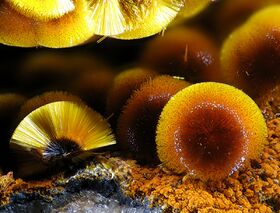Chemistry:Cacoxenite
From HandWiki
| Cacoxenite | |
|---|---|
 Cacoxenite, Minas de Horcajo, Castile-La Mancha, Spain | |
| General | |
| Category | Phosphate minerals |
| Formula (repeating unit) | Fe3+24Al(PO4)17O6(OH)12·17(H2O) |
| Strunz classification | 8.DC.40 |
| Crystal system | Hexagonal |
| Crystal class | Dipyramidal (6/m) (same H-M symbol) |
| Space group | P63/m |
| Unit cell | a = 27.559(1) Å, c = 10.55 Å; Z = 2 |
| Identification | |
| Color | Yellow to brownish yellow, reddish orange, golden yellow, deep orange, green; yellow in transmitted light |
| Crystal habit | Acicular, radial, stellate |
| Cleavage | None |
| Fracture | Uneven |
| Mohs scale hardness | 3–4 |
| |re|er}} | Silky |
| Streak | White |
| Diaphaneity | semitransparent |
| Specific gravity | 2.2–2.6 |
| Optical properties | Uniaxial (+) |
| Refractive index | nω = 1.575 – 1.585 nε = 1.635 – 1.656 |
| Birefringence | δ = 0.060 |
| Pleochroism | visible: O = Pale yellow E = Canary yellow to yellow orange |
| References | [1][2][3] |
Cacoxenite is an iron aluminium phosphate mineral[5] with formula: Fe3+24Al(PO4)17O6(OH)12·17(H2O).[3] Cacoxenite is associated with iron ores.[6] The name comes from the Greek κăκός for "bad" or "evil" and ξένος for "guest" because the phosphorus content of cacoxenite lessens the quality of iron smelted from ore containing it.[5][7]
It was first described in 1825 for an occurrence in the Hrbek Mine, Bohemia, Czech Republic.[3][6] It occurs as a secondary phase in oxidized magnetite and limonite deposits. It also occurs in novaculites and in iron and phosphorus rich sediments.[3]

References
- ↑ Mineralienatlas
- ↑ Cacoxenite Mineral Data
- ↑ 3.0 3.1 3.2 3.3 Cacoxenite: Cacoxenite mineral information and data
- ↑ Warr, L.N. (2021). "IMA–CNMNC approved mineral symbols". Mineralogical Magazine 85 (3): 291–320. doi:10.1180/mgm.2021.43. Bibcode: 2021MinM...85..291W.
- ↑ 5.0 5.1 Magdalena, Arya (2019-04-23). "Facts About Cacoxenite: Meanings, Properties, and Benefits" (in en-us). https://gemstagram.com/facts-about-cacoxenite-meanings-properties-and-benefits/.
- ↑ 6.0 6.1 "Cacoxenite: Meanings, Properties and Powers" (in en-US). 2019-04-30. https://meanings.crystalsandjewelry.com/cacoxenite/.
- ↑ "Cacoxenite". Handbook of Mineralogy. http://www.handbookofmineralogy.org/pdfs/cacoxenite. PDF File.
| Wikimedia Commons has media related to Cacoxenite. |
 |

